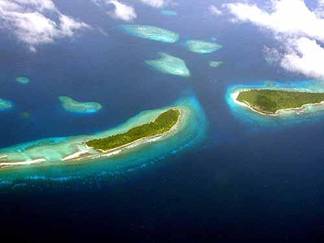 The low-lying Marshall Islands, a Pacific atoll chain that rises barely a metre above sea level, has announced plans for a wall to hold back rising sea levels.
The low-lying Marshall Islands, a Pacific atoll chain that rises barely a metre above sea level, has announced plans for a wall to hold back rising sea levels.
“We want to prevent erosion and stop flooding,” UN ambassador Phillip Muller said at the weekend, launching an appeal for $20.2 million in international donor funds to get the project underway.
The full cost of the protective seawall has not been released and Mr Muller said the initial plea for donor funds is for detailed engineering work on the project.
The vulnerability of the Marshalls was highlighted two years ago when floods hit the eastern shore of the main Majuro Atoll, causing several million dollars in damage and forcing dozens of islanders to live in temporary shelters.
The Honolulu-based National Weather Service, a US National Oceanic and Atmospheric Administration-supported agency, recently warned of possibly more severe flooding in the next two months.
The Marshall Islands, a nation of 29 coral atolls and five single islands, stretches across 800,000 square kilometres of Pacific Ocean but has only about 116 square kilometres of dry land, most of which is not more than a metre above the high-tide mark.
Mr Muller said the government is asking donors to put up climate change funding to help his country forestall pending floods.
The plan is to build a five-kilometre seawall on the leeward coast of Majuro Atoll for shore protection, as well as to landfill small bays to increase landmass as a buffer against rising sea levels and high waves during storms.
Nearly half of the country’s 55,000 population live in Majuro where few homes are more than 10 metres from the ocean and many are considerably closer.
The floods in December 2008 resulted from exceptionally high tides which peaked at the same time as powerful waves generated by storms at sea surged ashore to inundate many parts of Majuro’s eastern coastline.
From his UN office, Mr Muller has been pushing for access to billions of dollars in promised climate change aid for vulnerable countries.
But he says very little of the pledged money has flowed to the countries that most need it.
“We have only a short window of opportunity for accessing these funds,” he said.
“The money pledged is only for two to three years. We need to move fast.”
The $20 million towards the protective seawall was only an “initial” amount to get the protection work going and additional funding would be required.
The Marshall Islands, the scene of the US nuclear weapons tests in the 1950s, was a US-administered trust territory until becoming independent in 1986 under a Compact of Free Association between the two countries.
It is nearly 70 per cent underwritten by donor grants, with two countries providing the bulk of funding.
The United States injects about $75 million a year into government coffers, while Taiwan, which has diplomatic ties with the Marshalls, adds another $10 million.


